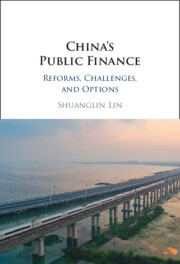Book contents
- China’s Public Finance
- Endorsement on Back Cover
- China’s Public Finance
- Copyright page
- Dedication
- Contents
- Figures
- Tables
- Preface
- About the Author
- 1 An Overview of China’s Public Finance
- 2 The Fall and Rise of Government Revenue
- 3 Value-Added Tax, Consumption Tax, and Other Taxes on Goods and Services
- 4 Individual Income Tax Reforms
- 5 Corporate Income Tax in China
- 6 The Size and Structure of Government Expenditure
- 7 Infrastructure Development and Financing
- 8 Social Security Reforms
- 9 Healthcare Reforms
- 10 China’s Growing Local Government Debt
- 11 Fiscal Relationship between the Central and Local Governments
- 12 Fiscal Reform for Equitable and Sustainable Growth
- References
- Name Index
- Subject Index
7 - Infrastructure Development and Financing
Published online by Cambridge University Press: 22 September 2022
- China’s Public Finance
- Endorsement on Back Cover
- China’s Public Finance
- Copyright page
- Dedication
- Contents
- Figures
- Tables
- Preface
- About the Author
- 1 An Overview of China’s Public Finance
- 2 The Fall and Rise of Government Revenue
- 3 Value-Added Tax, Consumption Tax, and Other Taxes on Goods and Services
- 4 Individual Income Tax Reforms
- 5 Corporate Income Tax in China
- 6 The Size and Structure of Government Expenditure
- 7 Infrastructure Development and Financing
- 8 Social Security Reforms
- 9 Healthcare Reforms
- 10 China’s Growing Local Government Debt
- 11 Fiscal Relationship between the Central and Local Governments
- 12 Fiscal Reform for Equitable and Sustainable Growth
- References
- Name Index
- Subject Index
Summary
Chapter 7 discusses China’s infrastructure development.It analyzes the ways in which infrastructure investment has been financed, including revenues from land sales, bank loans, infrastructure development funds, domestic and foreign debt, taxes, fees, and user charges. It shows the composition of funds for financing key infrastructures including transportation, telecommunication, energy, and sanitation. It demonstrates that China's infrastructures have grown rapidly in the past twenty-five years. It examines the reasons for the fast infrastructure development in China and the problems with infrastructure development, including a solid tax system, a pro-infrastructure spending system, expansionary fiscal policies, and large local government revenues from land sales and bank borrowings. It also evaluates China’s belt and road initiative and discusses the L17benefits and potential risks to the countries involved.
- Type
- Chapter
- Information
- China's Public FinanceReforms, Challenges, and Options, pp. 197 - 231Publisher: Cambridge University PressPrint publication year: 2022

